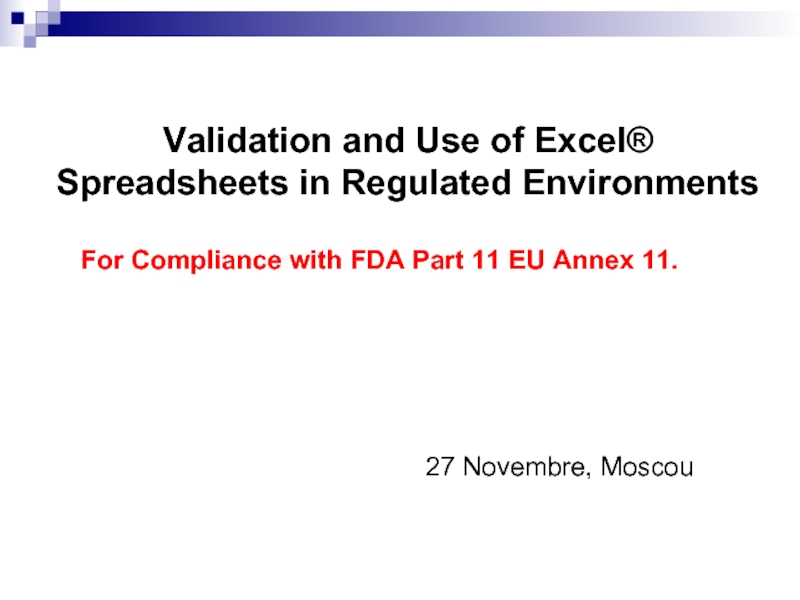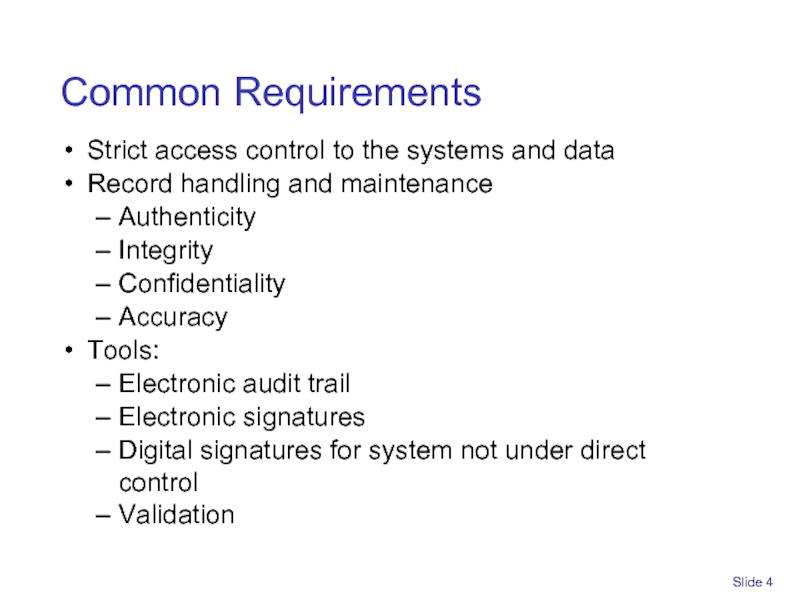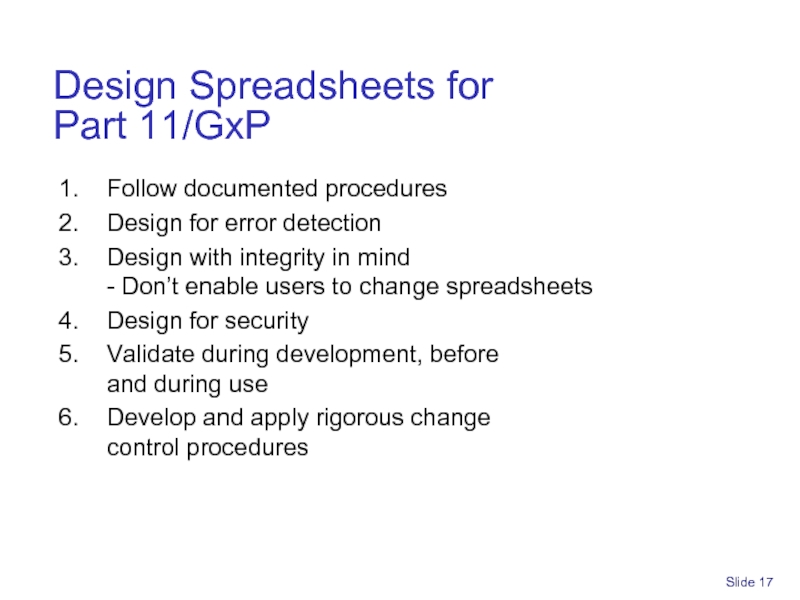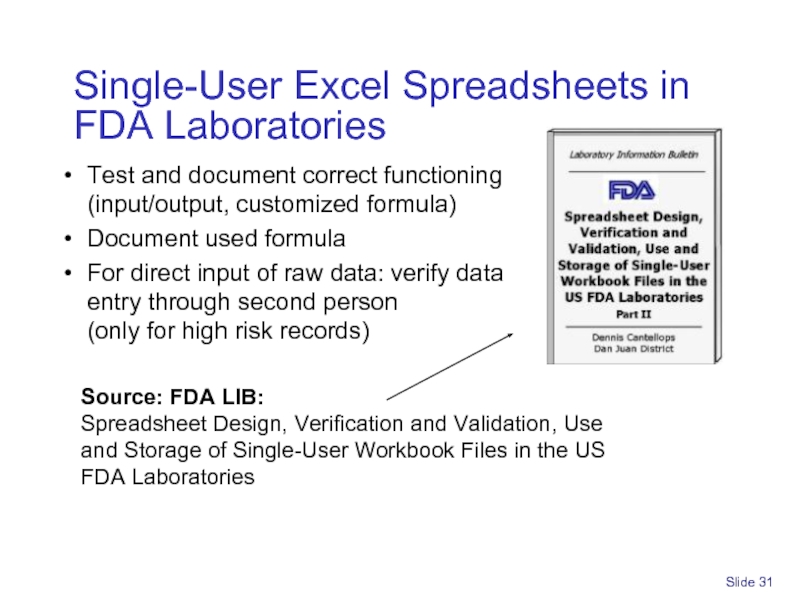27 Novembre, Moscou
- Главная
- Разное
- Дизайн
- Бизнес и предпринимательство
- Аналитика
- Образование
- Развлечения
- Красота и здоровье
- Финансы
- Государство
- Путешествия
- Спорт
- Недвижимость
- Армия
- Графика
- Культурология
- Еда и кулинария
- Лингвистика
- Английский язык
- Астрономия
- Алгебра
- Биология
- География
- Детские презентации
- Информатика
- История
- Литература
- Маркетинг
- Математика
- Медицина
- Менеджмент
- Музыка
- МХК
- Немецкий язык
- ОБЖ
- Обществознание
- Окружающий мир
- Педагогика
- Русский язык
- Технология
- Физика
- Философия
- Химия
- Шаблоны, картинки для презентаций
- Экология
- Экономика
- Юриспруденция
Validation and use of exce spreadsheets in regulated environments. (Part 11) презентация
Содержание
- 1. Validation and use of exce spreadsheets in regulated environments. (Part 11)
- 2. Slide Today’s Agenda Regulatory requirements/business requirements
- 3. Slide Regulations/Guidelines GxPs Systems should be
- 4. Slide Common Requirements Strict access
- 5. Slide FDA Part 11 Validation Guidance
- 6. Slide FDA Warning Letters No
- 7. Slide FDA Warning Letters Failure
- 8. Slide FDA Warning Letters "Your
- 9. Slide Warning Letter Failure to use
- 10. Slide Verification of Corrective Actions These
- 11. Slide Verification of Corrective Actions The
- 12. Slide Verification of Corrective Actions The
- 13. Slide European Medicines Agency GMP-Q&A Q:
- 14. Slide European Medicines Agency GMP-Q&A Q:
- 15. Slide Compliance Problems with Spreadsheets Easy
- 16. Slide What to do for GxP/Part
- 17. Slide Design Spreadsheets for Part
- 18. Slide With VBA Check and alert
- 19. Slide Design for Integrity and Authenticity
- 20. Slide Md5 Hash Calculations for File
- 21. Slide Design for Security Develop, implement
- 22. Slide What to Validate / What
- 23. Slide What does Validation of Spreadsheets
- 24. Slide Should we Test Standard Excel
- 25. Slide Recommendations from GAMP Document
- 26. Excel Spreadsheet Validation from Beginning to End
- 27. Excel Spreadsheet Validation from Beginning to End
- 28. Slide How to Comply with the
- 29. Slide Design for Tracking Changes (Audit
- 30. Slide Multi-User Excel Spreadsheets in FDA
- 31. Slide Test and document correct functioning
- 32. Slide Documentation for Part 11 FDA
- 33. Slide Paper Raw data Results
- 34. Slide Equipment e.g., autoclave or
- 35. Slide Example: Level 1
- 36. Slide Disable Menu and Tool Bars and CTRL Keys Example: Level 3
- 37. Slide Minimal Documentation (equally important for
- 38. Slide Slide Thank You
Слайд 1Validation and Use of Excel® Spreadsheets in Regulated Environments
For Compliance
Слайд 2Slide
Today’s Agenda
Regulatory requirements/business requirements
Recommendations from the FDA
Design Spreadsheet for Part
Validation during development and installation
How to ensure integrity&security of spreadsheets
How the FDA is using spreadsheets
Documentation requirements
Validation example from beginning to the end
Case studies for Part 11 compliance
Q&A's
Q&A's
Part 1
Part 2
Слайд 3Slide
Regulations/Guidelines
GxPs
Systems should be suitable for intended use
21 CFR Part 11
EU Annex 11 to GMPs Defines requirements for software and computer systems in EU GMP regulated environments
PIC/S Good Practice Guide Has lots of good recommendations on using computers in regulated environments
Слайд 4Slide
Common Requirements
Strict access control to the systems and data
Record
Authenticity
Integrity
Confidentiality
Accuracy
Tools:
Electronic audit trail
Electronic signatures
Digital signatures for system not under direct control
Validation
Слайд 5Slide
FDA Part 11 Validation Guidance
Spreadsheet Calculations and Macro Programs used
Testing should cover full range
End users should validate any program Macros and other customizations that they prepare
FDA Requirements
Spreadsheet Calculations and Macro Programs should comply with 21 CFR Part 11 (E-records/signatures)
Слайд 6Slide
FDA Warning Letters
No procedures are established to validate for
In addition, you continued to release products based on assay results generated by the spreadsheet that have not been verified for accuracy (W-237)
Spreadsheets intended to check for outliers and calculate mean, SC, % CV, not validated (W-201)
Ref: www.fdawarningletter.com
Validate Spreadsheets
Слайд 7Slide
FDA Warning Letters
Failure to validate computer software for its
Microsoft Excel spreadsheet software used manufacturing has not been validated for the purpose of generating a worksheet for formulation of reagents.
No documentation was found to establish or verify corrections made to the program. (W-125)
Ref: www.fdawarningletter.com
Validate Spreadsheets
Слайд 8Slide
FDA Warning Letters
"Your laboratory records did not include a
For example, the notebook does not document reference to the spreadsheet calculation used to generate the results.
Your SOP omits instructions to include in the notebook the reference to the spreadsheet calculation used to generate the results, as well as the raw data and calculations."
Ref: www.fdawarningletter.com (W-237)
Record Spreadsheet Calculations
Слайд 9Slide
Warning Letter
Failure to use fully validated computer spreadsheets to calculate
QA/QC Spreadsheet Validation, is deficient in that only a small range of values are being used to challenge computerized spreadsheet mathematical calculations.
Ref: www.fdawarningletter.com (W 063)
Validate Spreadsheets over wide range
Слайд 10Slide
Verification of Corrective Actions
These tests include the entry of the
Each spreadsheet is product specific and has a separate validation package
Each package contains the initial testing of the information as entered into the Spreadsheet, a blank spreadsheet, and a spreadsheet showing the calculation formulas used in the appropriate cells.
EIR
EIR = Establishment Inspection Report
Ref: www.fdawarningletter.com (W 106)
Validation
Слайд 11Slide
Verification of Corrective Actions
The package contains a list of the
Revised SOP "QA/QC Computer Spreadsheet Validation," contains directions for testing new and existing spreadsheets prior to use in analytical testing.
The spreadsheets are checked monthly by a familiar analyst with previously entered data.
The check results are compared to the originals to make sure that corruption of the file has not occurred
EIR
EIR = Establishment Inspection Report
Ref: www.fdawarningletter.com (W 106)
Validation
Слайд 12Slide
Verification of Corrective Actions
The firm now saves the spreadsheets in
Changes to spreadsheets cannot be saved in this format.
Two sets of CDs were made, one Set for the daily laboratory use and one master copy containing all spreadsheets kept by ….
lf one spreadsheet an a CD is changed, then a new CD is burned and the old one is archived.
The spreadsheet when printed out bears a file path at the bottom to assure it came from the CD
.
EIR
EIR = Establishment Inspection Report
Ref: www.fdawarningletter.com (W 106)
Integrity
Слайд 13Slide
European Medicines Agency GMP-Q&A
Q: Which type of accuracy checks (Annex
A: Data integrity should be ensured by suitably implemented and risk assessed controls. The calculations and the files should be secured in such a way that formulations are not accidentally overwritten. Accidental input of an inappropriate data type should be prevented or result in an error message (e.g. text in a numeric field and or a decimal format into integer field) - so called boundary checks are encouraged.
Ref: EMA Website
Слайд 14Slide
European Medicines Agency GMP-Q&A
Q: Are there any specific considerations for
A: Validation according to paragraph 4 of Annex 11 is required at least for Spread-sheets that contain custom code (e.g. Visual basic for applications). Formulas or other types of algorithms should be verified for correctness..
Ref: EMA Website
Слайд 15Slide
Compliance Problems with Spreadsheets
Easy access to programs
Everybody (not trained on
Everybody can change ==>Frequent change without control
No validation, no documentation
Many different environments (operating systems, PC hardware)
Many versions in use (local PC, server, inbox, delete folders)
No or insufficient documentation
Typically do not comply with regulations (e.g., Part 11), and QA Unit is not aware of this
Слайд 16Slide
What to do for GxP/Part 11 Compliance ?
Use other programs
e.g.,
Use document management software with built-in Excel support and Part11/GxP functionality, (E.g., Agilent OpenLab)
Develop, implement, and enforce procedures for development and use of Spreadsheets with quality, security and validation in mind.
Evaluate and use add-on software with more security and compliance functionality, e.g., e-audit trail, e-signatures Examples: e-Infotree from Cimcon, www.part11solutions.com, ExcelSafe from Ofnisystems, www.ofnisystems.com/ExcelSafe
Today's focus
Слайд 17Slide
Design Spreadsheets for
Part 11/GxP
Follow documented procedures
Design for error detection
Design
Design for security
Validate during development, before and during use
Develop and apply rigorous change control procedures
Слайд 18Slide
With VBA
Check and alert the user if a single data
Spreadsheet should detect errors during data entry
- wrong type, e.g.,
string characters instead of numbers
- wrong sequence of entries
- wrong data range
- wrong format (e.g., date)
Spreadsheet should prompt the user in case of wrong entries, and not crash
Design for Error Detection
Слайд 19Slide
Design for Integrity and Authenticity
Protect all cells not used
Protect use of Excel sheet by passwords
Store and load from write protected directory (e.g., secure server or CD)
Display directory, subdirectories, file name and sheet name at the bottom of the spreadsheet
Display date and time of last data entry
Display&print operator name
Verify file integrity with hash function
With VBA (example 3)
Disable menu and tool bars to limit function to the intended use
Disable ‘save’ and ‘save as’ Disable
cut/copy and paste control keys
Слайд 20Slide
Md5 Hash Calculations for File Integrity Check
Based on security
Used to check accuracy or e-mail transfer
Used for digital signatures
Used to verify proper software installation
Used to verify file transfer accuracy in networks
Calculate hash value (124 bit string)
Store the value
For verification: recalculate and compare with original value
Слайд 21Slide
Design for Security
Develop, implement and test procedures for limited system
Configure and use secure operating systems (Windows 7, XP, VISTA)
If available, use secure server for storage of spreadsheets and access to spreadsheets
Maintain user lists with authorized access
Слайд 22Slide
What to Validate / What not to Validate
Not to Validate
Excel
Standard calculations under normal conditions (GAMP Category 3)
Validate
Everything we customize, e.g., - user interface (input/outputs) - validation functions for data entry - macros (VBA Scripts)
Extreme conditions (at and above/beyond limits)
Security functions (e.g., passwords, cell protection)
Spreadsheet integrity (e.g., hash function)
Слайд 23Slide
What does Validation of Spreadsheets Include?
Planning
Writing specifications
- functional specifications
- computer
Design and code review
Installation qualification/documentation
Testing during development and after installation
Change control/requalification
Validation report
Слайд 24Slide
Should we Test Standard Excel Functions?
Standard functions used in normal
Verify standard functions if used in extreme ranges (e.g., very small numbers) and if there are indications for problems with Excel
Use commercial calculator for verification for 2.
Regularly check the vendor’s website for errors (need written procedure)
Слайд 25Slide
Recommendations from GAMP
Document the purpose of the spreadsheet
Verify that the
Document formula
Verify any cell links
Protect the spreadsheet
Strict access controls
Validate data input of critical data
Ensure integrity of electronic data
No need to verify accuracy of native functions
Ref: (GAMP 5, Page 294)
Слайд 26Excel Spreadsheet Validation from Beginning to End (1)
New spreadsheet proposed
Proposal approved
Establish
Develop preliminary project plan
Interview anticipated user departments about use of the SS
Update project plan and distribute to QA and operation manager
Interview anticipated users for intended use and requirements
Interview anticipated users about required functions
Draft of requirement specifications
Conduct risk assessment
Qualify developer/supplier
Develop template for design specification and review
Develp and review design specification
Slide
Слайд 27Excel Spreadsheet Validation from Beginning to End (2)
Develop functional specification test
Distribute test plan to test persons (user representatives)
Test functional specifications
Evaluate test results (and correct deficiencies, if there are any)
Develop a list with anticipated users
Distribute spreadsheet to anticipated users
Install and document spreadsheet
Test spreadsheet in the user‘s environment
Add the spreadsheet to the company‘s spreadsheet data base
Write the validation report
Repeat tests from (21) every quarter
Follow documented procedures for any changes and record changes in the change history
Slide
Слайд 28Slide
How to Comply with the Audit Trail Requirement
Procedures
For low
Print and sign For low risk systems
Use ‘Track Changes’ function For medium risk systems
Use 3rd party software e.g., ExcelSafe, e-Infotree For high risk systems
Слайд 29Slide
Design for Tracking Changes (Audit Trail)
Click on Tools -select Track
Select which changes you want to track and time range
Result: Changes can be reviewed and printed
Слайд 30Slide
Multi-User Excel Spreadsheets in FDA Laboratories
Source: FDA LIB:
Spreadsheet Design
User ID/Password for secure log-on
MS NTFS to limit access to files
Store spreadsheets on write protected server directories
Validate spreadsheet applications
Control and archive spreadsheets for internal audits
Standardize design of templates (use of colors, cell protection)
Слайд 31Slide
Test and document correct functioning
(input/output, customized formula)
Document used formula
For direct
Source: FDA LIB:
Spreadsheet Design, Verification and Validation, Use and Storage of Single-User Workbook Files in the US FDA Laboratories
Single-User Excel Spreadsheets in FDA Laboratories
Слайд 32Slide
Documentation for Part 11
FDA Recommendation: We recommend that each study
Document your business practices
especially important: where can users change records (e.g., spreadsheet templates)
Define and document your rational behind part 11 controls (e.g., audit trail, archiving on paper vs. electronic, validation)
Слайд 33Slide
Paper
Raw data
Results
PC
Excel software
Calculates results
Events
Original e-record stored
User has authorized access to
Approval
A, B
Example – Using Excel Template as Calculator
Records required by predicate rule
No __ Explicit _x Implicit __
Regulated activity relies on e-records
Yes _x No__
Impact on product quality
High _x Medium __ Low __ No __
Business Practice - Steps
Spreadsheet loaded from write-protected server
Data from paper is typed into an Excel spreadsheet
Example: weights of balance
Spreadsheet performs calculations and results are printed and signed
All printed results are archived together with original data
No electronic records stored
Printer
No e-audit trail
Load spreadsheet from write protected server
Print file source with each result
Maintain records in paper form
Recommendations
C
Слайд 34Slide
Equipment
e.g., autoclave
or UV for
Dissolution
Computer 1
Data acquisition
Primary data evaluation
Data generation
Data is stored temporarily and processed
Authorized access to data
Operators can manipulate data
Computer 2
Excel software
Primary data evaluation
B
B, C, D
Records required by predicate rule
No __ Explicit _x Implicit __
Regulated activity relies on e-records
Yes _x No__
Impact on product quality
High _x Medium __ Low __ No __
Business Practice - Steps
Data generated by equipment
(e.g., process parameters, signals)
Data transferred to computer 1 for primary data evaluation (no operator interaction)
Intermediate results transferred to computer 2 for secondary evaluation with operator interaction
Results from secondary evaluation are signed on computer 2 and archived
Printer
A
Automatic Transfer of Intermediate Data to Excel
Remark: Computer I and II can be combined
No e-audit trail on Comp1
E-audit trail on Comp2
E-signature on Comp2
Need Excel remediation software
Comp1 and Comp 2 must be validated
Recommendations
Слайд 37Slide
Minimal Documentation
(equally important for new and existing spreadsheets)
A description of
Description of formulas used
User manual incl. description of color coded cells
Explanation of the relationship of formulas used in procedures to Excel equations
Listing of VBA Macros
Test sheets with anticipated results, acceptance criteria and actual results
Security and password maintenance, user lists
Documentation of operating systems, spreadsheet version, workbook version, date of installation











































